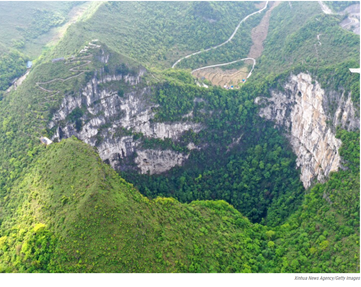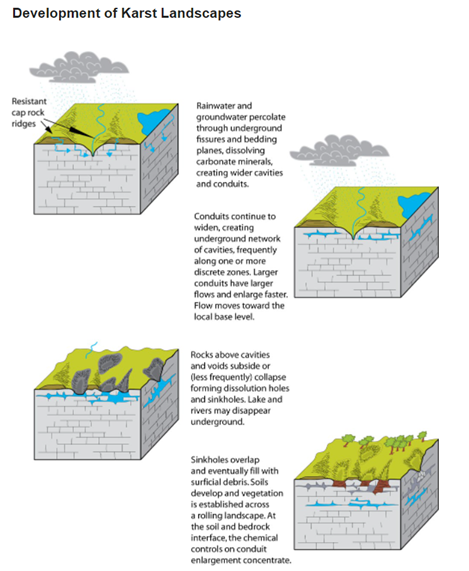

Context
A cave exploration team has discovered an ancient forest at the bottom of a giant karst sinkhole in Leye County in south China’s Guangxi Zhuang Autonomous Region.
About
- The sinkhole measures 306 metres in length, is 150 metres in width and 192 metres in depth, with its volume exceeding 5 million cubic meters.
- Given these dimensions, the sinkhole can be categorised as a large sinkhole.
- In Mandarin, giant sinkholes are called Tiankeng or “heavenly pit”.
About Sinkhole:
- Sinkholes are depressions formed in the ground when layers of the Earth’s surface start collapsing into caverns.
- They can occur suddenly and without warning, because the land under the surface of the Earth can stay intact for a period of time until the spaces get too big.
- Sinkholes can be formed due to natural processes or human activity.
- Typically, sinkholes form in areas of “karst” terrains, where the rock below the surface of the Earth can be easily dissolved by groundwater.
- Essentially, this means that when rainwater seeps into the ground, the rock below the surface of the Earth starts dissolving, leading to the creation of spaces.
- This process is a slow and gradual one and can sometimes take hundreds or thousands of years.
- As per NASA, karst geology covers about 13 per cent of eastern and south-eastern Asia.
- Karst terrain is created from the dissolution of soluble rocks, mostly limestone and dolomite and is characterised by distinctive landforms such as caves, sinkholes and springs.

Karst Landscape:
- Karst is an area of land made up of limestone.
- Limestone, also known as chalk or calcium carbonate, is a soft rock that dissolves in water.
- As rainwater seeps into the rock, it slowly erodes.
- Karst landscapes can be worn away from the top or dissolved from a weak point inside the rock.
- Karst landscapes feature caves, underground streams and sinkholes on the surface.
- Where erosion has worn away the land above ground, steep rocky cliffs are visible.
- Shilinis a karst formation in southern China. In Chinese, shilin means stone forest.
- Shilin got its name because the tall rocks that formed due to erosion look like stone trees.
- Shilin is part of a larger karst landscape called the South China Karst, which spreads across the Chinese provinces of Guangxi, Guizhou, and Yunnan.


